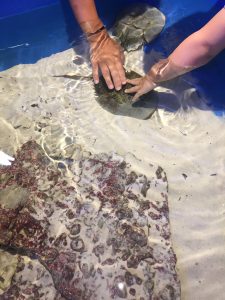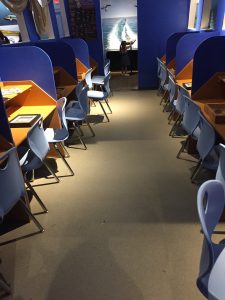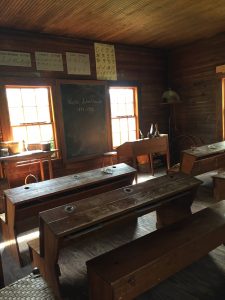TL;DR:
- Students respond better to classroom spaces that are interactive and encourage exploration, movement, and collaboration.
- Students learn science better through instruction that allows them to have access to the entire classroom space when inspiration strikes.
- Consider taking the time to honestly reflect on your classroom space to make it more engaging to your students.
How are you using your classroom spaces?
I began reflecting on this question during a recent visit to the Roper Mountain Science Center in Greenville, SC.
If you are ever in the Greenville, SC area and have the opportunity to visit Roper Mountain, I highly recommend it! It is an interactive science center that is affiliated with the Greenville School District. They have several interactive exhibits related to natural history, a planetarium, an observatory, a living history farm, and hiking trails (just to name a few!). While I was exploring, I noticed that children were running to certain areas and ignoring others.
Students should not be recipients of information, but creators of content. They should be doing science, not reading about it! Students should be allowed to make mistakes and learn from them within the safe space of your classroom. Share on XWhere did I see children running to? They ran towards the spaces where they could:
- move and touch things

Interactive exhibit at Roper Mountain Science Center
- interact with the animals
- walk through the rainforest
- climb on the structures along the trails
- open/close the drawers corresponding to the displays
- walk through and interact with the living history farm exhibits where they could pump water, feed animals, wash clothes (yes, I saw it happen!), and mine for gems.
Where did I NOT see children?
In the spaces where there were chairs and desks with books laid out, set in neat rows (even though this space was created to look like a submarine observation vessel in an attempt to make it an immersive experience).

Reading center at Roper Mountain Science Center
Guess who looked happy in the interactive spaces? The children!
Guess who looked miserable? The adults!
And, because it is adults who design the spaces, is it any surprise that our learning environments tend to favor desks in rows? Adults have visions of smiling, compliant, quiet children reading books, taking notes, and raising their hands in these spaces. But, children tend to have very different ideas about how to use a space, which leads to conflict. For example, I heard so many of the adults (parents/guardians) calling out things like:
- “Don’t touch!”
- “Come over here!”
- “Don’t go over there!”
- “Stop climbing on that!”
- “We don’t have time to see that!”
- “Hurry up, we want to make sure we can see everything!”
That last one really hit home for me. This scenario plays out far too often in our classrooms—teachers try to cover all of the content at a rapid pace, leaving no time for deep inquiry, which dampens the spark of curiosity in our children. Don’t worry, I will dive into that topic in a future blog!
These adult-centered ideas have not changed for centuries.

Model of an 1800s classroom at Roper Mountain Science Center
Roper Mountain has an exhibit in the living history farm that shows a classroom from the early 1800s. It is easy to identify (no signage needed)—a chalkboard at the front, a teacher desk in the front, and rows of benches where students sat. The biggest change I saw from this classroom and those that you can find in many classrooms across the US today is that “modern” classrooms have either a whiteboard or Smartboard in place of the chalkboard and rows of desks instead of rows of benches.
Considering how much the world has changed in 200 years, is this really the pace at which we should be moving to educate the next generation of problem solvers and future scientists?
I challenge all teachers to take an honest look at their classrooms AND their instruction and ask themselves if they are teaching for the future or teaching in the past. And, if you determine that you are stuck in the past, I further challenge you to make a list of action steps that you can implement today to become a better teacher that prepares our students for a future that we can’t even imagine.
[scroll down to keep reading]
How can you BETTER use your classroom spaces?
I understand that there are financial and physical constraints to consider, but educators are creative and resourceful. How can you change your seating to allow for more collaboration? Are you spending the majority of your class time lecturing in front of the class or do you allow for movement, student inquiry, and student exploration to drive your instruction? If we are not allowing our students to lead the instruction, how could they possibly be ready to go into the “real world” and solve problems with creativity and inventiveness and drive forth innovation?
Every educator should strive to have a classroom where the students are actively engaged in learning. Students should not be recipients of information, but creators of content. They should be doing science, not reading about it! Students should be allowed to make mistakes and learn from them within the safe space of your classroom. I appreciate the value of hands-on, messy, and exciting science instruction…and our classroom spaces should allow for this type of learning to happen on a daily basis.
Please reach out and connect with me about your use of classroom space. What are your challenges, successes, and questions? I look forward to continuing this conversation so that we can learn to science better.
About Holly Stuart
Holly Stuart is an 8th grade science and design teacher in South Carolina. Her educational passions include finding new and innovative ways to get more students interested in STEAM, student-inspired discovery through inquiry, and learning science by doing science.
In addition to her out-of-the-box thinking in the classroom, she has successfully implemented The Grid Method into her teaching practice which led to her becoming a Teach Better Team Ambassador. Holly is married to her high school sweetheart and is a mother to three children.
When not teaching, she enjoys traveling and being outside with her family. Some of their favorite outdoor activities include hiking, running, and biking. (Holly often brings her telescope, binoculars, and microscopes with her on hikes!) Her indoor hobbies include reading, coloring, and learning more about sketchnoting and drawing.




